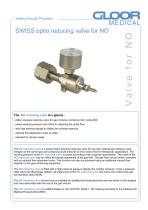
NO pressure regulator PM0135Elaboratorymedicaladjustable-flow
Add to favorites
Compare this product
fo_shop_gate_exact_title
Characteristics
- Fluid type
- NO
- Applications
- laboratory, medical
- Features
- adjustable-flow, high-pressure
- Flow
Max.: 15 l/min
(3.96 us gal/min)Min.: 0.1 l/min
(0.03 us gal/min)- Inlet pressure
200 bar
(2,900.8 psi)- Output pressure
4.2 bar
(60.9 psi)- Height
70 mm
(2.8 in)- Weight
500 g
(17.6 oz)- Width
75 mm
(3 in)- Depth
135 mm
(5.3 in)
Description
preset working pressure and orifice for adjusting the outlet flow
with high pressure gauge to display the cylinder pressure
optional fine adjustment valve at outlet
intended for clinical usage
The NO reducing valve is a preset piston pressure reducing valve for use with medical gas mixtures using nitrogen as the carrier gas and containing small amounts of nitric oxide (NO) for therapeutic applications. The working pressure of the NO reducing valve is preset according to the customer specification. The outlet of the NO reducing valve has an orifice for precise adjustment of the gas flow. The gas flow can be further controlled with an optional fine adjustment valve. This function can also be achieved using an additional internal flow regulator in the gas-consuming equipment.
The NO reducing valve is fitted with a high pressure gauge to display the cylinder pressure. It has a pressure relief valve that discharges radially. All metal parts of the NO reducing valve that come into contact with gas are stainless steel (INOX).
The NO reducing valve should only be installed by qualified technical personnel who are aware of the dangers and risks associated with the use of the gas mixture.
The NO reducing valve is certified based on norm EN ISO 10524-1. CE marking according to the Guideline for Medical Products 93/42/EEC.
Catalogs
SWISS optio NO
2 Pages
Related Searches
- Medical cart
- Medical device cart
- Hospital cart
- Equipment cart
- Emergency cart
- Gas pressure regulator
- Gas flow meter
- Compact cart
- Hospital flow meter
- Medical pressure reducer
- O2 flow meter
- O2 pressure regulator
- Humidifier
- Adjustable-flow pressure reducer
- Column flow meter
- Medical device trolley
- O2 gas mixer
- Medical gas mixer
- Laboratory pressure reducer
- Single-stage pressure reducer
*Prices are pre-tax. They exclude delivery charges and customs duties and do not include additional charges for installation or activation options. Prices are indicative only and may vary by country, with changes to the cost of raw materials and exchange rates.


